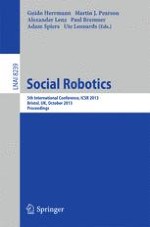2013 | Book
Social Robotics
5th International Conference, ICSR 2013, Bristol, UK, October 27-29, 2013, Proceedings
Editors: Guido Herrmann, Martin J. Pearson, Alexander Lenz, Paul Bremner, Adam Spiers, Ute Leonards
Publisher: Springer International Publishing
Book Series : Lecture Notes in Computer Science
